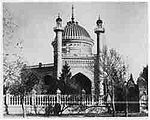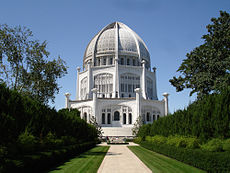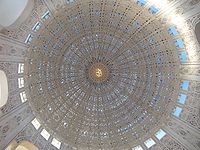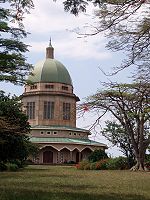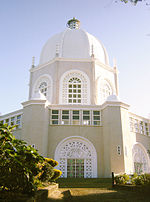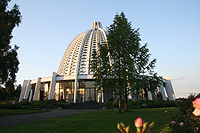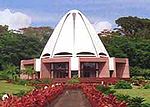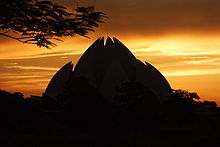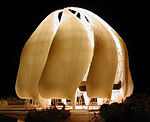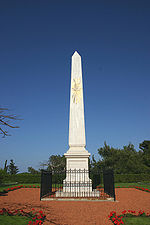- Bahá'í House of Worship
-
 A map of the location of Bahá'í Houses of Worship worldwide; green represents countries that currently have Bahá'í Houses of Worship (with a blue dot for the city); red represents countries where a House of Worship existed, but no longer does; light green represents countries where Houses of Worship were planned in 1963.
A map of the location of Bahá'í Houses of Worship worldwide; green represents countries that currently have Bahá'í Houses of Worship (with a blue dot for the city); red represents countries where a House of Worship existed, but no longer does; light green represents countries where Houses of Worship were planned in 1963.
Central figures Key scripture Kitáb-i-Aqdas · Kitáb-i-Íqán
The Hidden Words
The Seven ValleysInstitutions Administrative Order
The Guardianship
Universal House of Justice
Spiritual AssembliesHistory Notable individuals Shoghi Effendi
Martha Root · Táhirih
Badí‘ · Apostles
Hands of the CauseSee also Symbols · Laws
Index of Bahá'í Articles
Teachings · Texts
Calendar · Divisions
Pilgrimage · PrayerA Bahá'í House of Worship, sometimes referred to by its Arabic name of Mashriqu'l-Adhkár (Arabic: مشرق اﻻذكار, "Dawning-place of the remembrances of God"),[1] is the designation of a place of worship, or temple, of the Bahá'í Faith. The teachings of the religion envisage Houses of Worship being surrounded by a number of dependencies dedicated to social, humanitarian, educational, and scientific pursuits, although none has yet been built to such an extent.[2][3]
Only eight Houses of Worship have been built around the world[4] (this includes one in Ashgabat, Turkmenistan that has since been destroyed), with a ninth soon to be constructed in Chile. Bahá'í communities own many properties where Houses of Worship remain to be constructed as the Bahá'í community grows and develops further. The Houses of Worship are open to the public, and are exclusively reserved for worship, where sermons are prohibited and only scriptural texts may be read. Most Bahá'í meetings occur in local Bahá'í centres, individuals' homes, or rented facilities.[2]
Contents
Description
The Bahá'í House of Worship was first mentioned in Bahá'u'lláh's book of laws, the Kitáb-i-Aqdas, as the Mashriqu'l-Adhkár (Arabic: مشرق اﻻذكار "Dawning-place of the Mention of God"), and the details of the institution were then elaborated by both Bahá'u'lláh and his successor, `Abdu'l-Bahá.[3]
Bahá'í literature directs that a House of Worship should be built in each city and town, and emphasizes that its doors must be open to all regardless of religion, or any other distinction. The Bahá'í laws emphasize that the spirit of the House of Worship must be a gathering place where people of all religions may worship God without denominational restrictions.[3] The Bahá'í laws also stipulate that only the holy scriptures of the Bahá'í Faith and other religions can be read or chanted inside in any language; while readings and prayers may be set to music by choirs, no musical instruments may be played inside.[3] Furthermore no sermons may be delivered, and no ritualistic ceremonies practiced.[3]
All Bahá'í temples share certain architectural elements, some of which are specified by Bahá'í scripture. 'Abdu'l-Bahá stipulated that an essential architectural character of a House of Worship be that it requires to have a nine-sided circular shape ( Nonagon ).[5] While all current Bahá'í Houses of Worship have a dome, they are not regarded as an essential part of their architecture.[6] Bahá'í scripture also states that no pictures, statues or images may be displayed within the House of Worship and no pulpits or altars incorporated as an architectural feature (readers may stand behind simple portable lecture stands).[3] To date all the Houses of Worship built or planned have a single, undivided room under their dome. Furthermore, in all seven, the seats in the auditorium face the Shrine of Bahá'u'lláh in 'Akká, Israel. While each of the Houses of Worship is unique, the designs, through the selection of materials, landscaping and architecture, reflect the indigenous cultural, social and environmental elements of their location, to a greater or lesser degree.[3]
Bahá'í literature also stipulates that the Houses of Worship be surrounded by a complex of humanitarian, educational, and charitable institutions such as schools, hospitals, homes for the elderly, universities, hostels, and other social and humanitarian institutions to serve the areas in which they stand.[3][7] Shoghi Effendi, the Guardian of the Bahá'í Faith, stated that the functions of the House of Worship would be complementary to those of the Bahá'í centre, and that it would be desirable if both these buildings would be on the same site.[8][9] He also describes the future interaction between the Mashriqu'l-Adhkár (worship) and its dependencies (service) as "capable of removing the ills that have so long and so grievously afflicted humanity".[10]
The seven existing Houses of Worship were built as the Bahá'í community could support their construction through voluntary contributions. There are no collections during services and only Bahá'ís are permitted to contribute to the Bahá'í funds, including funds for the construction and maintenance of the House of Worship. The Houses of Worship are administered and maintained by the National Spiritual Assembly of the Bahá'ís of the country in which they are located.[3] The Shrine of the Báb and other buildings at the Bahá'í World Centre are not Houses of Worship, although tourists often mistakenly refer to the Shrine as a Bahá'í temple.
History
Ashgabat, Turkmenistan
- See also Bahá'í Faith in Turkmenistan.
The first Bahá'í House of Worship was built in the city of 'Ishqábád, then ruled by Russia and now the capital of Turkmenistan. It was started in 1902 and completed in 1908. The design was prepared by Ostad Ali-Akbar Banna, and the construction was supervised by Vakílu'd-Dawlih, later named one of the nineteen Apostles of Bahá'u'lláh.[3][11]
'Ishqábád is located in the desert plain of western Turkmenistan near the foothills of the Alborz Mountains. Under the protection and freedom given by the Russian authorities, the number of Bahá'ís there rose to over 1,000 and for the first time anywhere in the world a true Bahá'í community was established, with its own schools, medical facilities, cemetery, etc. Eventually the Bahá'ís in 'Ishqábád decided to build the institution of the spiritual and social heart of the Bahá'í community: the Mashriqu'l-Adhkár.
The House of Worship itself was surrounded by gardens. At the four corners of the garden were four buildings: a school, a hostel where travelling Bahá'ís were entertained, a small hospital, and a building for groundskeepers. The Bahá'ís lived as much as possible in proximity to the House of Worship. It was the centre of the community materially, as well as spiritually. The House of Worship in 'Ishqábád has been the only house of worship thus far to have the humanitarian subsidiaries associated with the institution built along side it.[11]
After serving the community for two decades, the House of Worship was expropriated by the Soviet authorities in 1928 and leased back to the Bahá'ís. This lasted until 1938, when it was fully secularized by the communist government and turned into an art gallery. The 1948 Ashgabat earthquake seriously damaged the building and rendered it unsafe; the heavy rains of the following years weakened the structure, and it was demolished in 1963 and the site converted into a public park.[3]
Existing structures
There are currently seven Bahá'í Houses of Worship, with an eighth under construction.
Wilmette, Illinois, U.S.
Main article: Bahá'í House of Worship (Wilmette, Illinois)The cornerstone for the Bahá'í House of Worship in Wilmette, Illinois was brought to the site by Nettie Tobin and accepted in 1912 by 'Abdu'l-Bahá during his only visit to the United States and Canada. Construction began in 1921 and was completed in 1953, with a delay of several years during the Great Depression and World War II. The Wilmette House of Worship is the largest and the oldest surviving Bahá'í House of Worship. Known by Baha'is as the "Mother Temple of the West" and formally as the "Bahá'í House of Worship for the North American Continent", it stands in north suburban Cook County, on the shores of Lake Michigan, at 42°04′27.88″N 87°41′05.89″W / 42.0744111°N 87.6849694°W. The cladding is made of white portland cement concrete with both clear and white quartz aggregate. It has received numerous design awards, and is a prominent Chicago-area landmark. In 1978, it was added to the National Register of Historic Places.[12]
The height of the auditorium is 138 feet (42 m), and the diameter of the dome is 90 feet (27.5 m). The auditorium seats 1,192 visitors.[13] Like some other Bahá'í temples, it has a gallery balcony from which choirs or soloists may perform. No instrumental music is allowed during services in the auditorium, although all kinds of music may be performed in the meeting room below. In general, no videography, photography, or any other activity inconsistent with quiet meditation is allowed in the auditorium. The building is open to visitors every day of the year. Currently, devotional services are held at 9:15 a.m., 12:30 p.m. and 5.15 p.m. daily. A Visitor's Center, located underneath the main auditorium, includes restrooms, offices, a bookstore, library and research room, a viewing room for films, and a Foundation Hall, which is used for large meetings and holy day celebrations. The large underground area also contains offices not regularly open to the general public, including a media center, studios, and the Baha'i Archives, which can be visited by appointment.
The principal architect was Louis Bourgeois, but the interior cladding was designed by Alfred Shaw of Shaw, Metz, and Dolio. Engineering plans were prepared by Allen McDaniel of The Research Service of Washington, D.C. The general contractor was George A. Fuller, Co. Both the pioneering exterior and interior cladding were fabricated and constructed by John Joseph Earley and the Earley Studio.[14]
The Bahá'í House of Worship is a place of worship for all people. The only decorative art inside and out involves shapes and designs made by intersecting lines. There are no images of people or places. The building itself is decorated inside and out with verses from the Baha'i Writings, all of them by Bahá'u'lláh. As there are nine entrances to the building, there are nine verses above the doors and nine inside the buildings above the alcoves.
The verses outside are engraved into the stone, in large legible letters. Above the doors are small engraved versions of the "Greatest Name", one of several Bahá'í symbols and an elaborate decorative design that includes the letters ABHA, representing the prayer "Alláh u Abhá" (God is Most Glorious) in Arabic. It is the numerical value of these four letters in the words abha and baha (for Bahá'u'lláh) that add up to total nine, one of reasons Bahá'í House of Worships are nine-sided.
The most decorative element on the outside of the building is the tracery on the nine towers. These are intertwined with the generally recognized symbols of many world religions, including the Cross, the star and crescent, the Star of David, and the original swastika design, an ancient symbol having arms bent at right angles, used for thousands of years as a representative symbol of world religions such as Hinduism, Buddhism, and Jainism. The only decorative symbol inside the auditorium is a large, lighted version of the Greatest Name in the exact center of the inside of the dome.
For many years the Bahá'í House of Worship was associated with a "home for the aged", operated by the U.S. Bahá'í community. The Bahá'í Home has since closed, although the building remains in use for a local Baha'i School and regional training center.[15]
On April 30, 2007, the Bahá'í House of Worship was named one of the Seven Wonders of Illinois by the Illinois Bureau of Tourism representing the Chicago metropolitan area.[16]
Kampala, Uganda
The Mother Temple of Africa is situated on Kikaaya Hill, in Kawempe Division, in northern Kampala, Uganda's capital and largest city. It was designed by Charles Mason Remey. Its foundation stone was laid in January 1958, and it was dedicated on January 13, 1961.
The building is more than 130 feet (39 m) high, and over 100 meters in diameter at the base. The dome, composed of lace-like tiles, rises over 124 feet (37 m) high and is 44 feet (13 m) in diameter. The foundation goes 10 feet (3 m) underground to protect it from earthquakes common in this part of the world.
The green dome is made of fixed mosaic tiles from Italy, and the lower roof tiles are from Belgium. The walls of the temple are of precast stone quarried in Uganda. The colored glass in the wall panels was brought from Germany. The timber used for making the doors and benches was from Uganda. The 50-acre (200,000 m2) property includes the House of Worship, extensive gardens, a guest house, and an administrative center.[17]
Sydney (Ingleside), Australia
The Temple in Sydney, Australia was dedicated on September 17, 1961 and opened to the public after four years of construction. The initial design by Charles Mason Remey was approved in 1957, and given to Sydney architect John Brogan to develop and complete. Construction materials include local hardwoods and concrete surmounted by a dome, with seating for six hundred people. The building stands 38 metres in height, has a diameter at its widest point of 20 metres, and is a highly visible landmark from Sydney's northern beaches.[18]
The surrounding gardens contain native plants including waratahs, several grevillea including the unique caleyi, the native pea, wattle and woody pear, plus three species of eucalypts. Other buildings located on the site include a visitor's centre, bookshop, picnic area, hostel, caretaker's cottage, and the administrative offices of the Australian Baha'i community.[19]
The property is set high in a natural bushland setting of 380,000 square metres (38 hectares) in Ingleside, a northern suburb overlooking the Pacific Ocean. This Temple serves as the Mother Temple of Australia.
In 2005-2006 this temple was threatened by nearby bush fires which approached but never reached the temple grounds.
Frankfurt (Langenhain-Hofheim), Germany
The Mother Temple of Europe is located at the foot of the Taunus Mountains of Germany, in the village of Langenhain, in the Frankfurt suburb of Hofheim, Hesse. It was designed by Teuto Rocholl. It was completed in 1964 and is made of steel, aluminium, and glass. 540 diamond-shaped windows give the dome an optical lightness and permit the sunlight to play in it. The outstanding characteristic acoustics of this setting are created by the reverberation within the dome and the resonance of its myriad window ledges. Choirs here sometimes sing while standing around the circumference of the temple floor, with the audience in the center.
Currently there are plans to construct a home for the aged as the first dependency of this House of Worship.
Panama City, Panama
The Bahá'í temple in Panama City, Panama, completed 1972, designed by Peter Tillotson. It serves as the mother temple of Latin America. It is perched on a high cliff, "Cerro Sonsonate" ("Singing Hill"), overlooking the city, and is constructed of local stone laid in a pattern reminiscent of Native American fabric designs.
The dome is covered with thousands of small oval tiles, and the entrance gates of the temple are constructed in a unique three-dimensional design each consisting of an equilateral triangle of three vertical posts with multiple rows of bars stretching between them at various angles, each row of which gradually changes from vertical to horizontal.
Tiapapata, Samoa
See also: Bahá'í Faith in SamoaThe Bahá'í House of Worship in Tiapapata, 8 km from Apia, Samoa, was completed in 1984 and serves as the Mother Temple of the Pacific Islands. The design was by Hossein Amanat, and was dedicated by Malietoa Tanumafili II, King of Samoa (1913–2007), who was the first reigning Bahá'í monarch. Its 30-meter domed structure is open to the public for individual prayer, commemoration of Baha'i holy days, and weekly devotional meetings. The structure is completely open to the island breezes.
Delhi, India
 The Bahá'í House of Worship in Delhi, India, located at 28°33′11.46″N 77°15′35.10″E / 28.5531833°N 77.25975°E
The Bahá'í House of Worship in Delhi, India, located at 28°33′11.46″N 77°15′35.10″E / 28.5531833°N 77.25975°E
The Bahá'í temple in Delhi, India was completed in 1986 and serves as the Mother Temple of the Indian subcontinent. It has won numerous architectural awards and been featured in many newspaper and magazine articles. The architect was an Iranian, who now lives in Canada, named Fariborz Sahba.
Inspired by the lotus flower, its design is composed of 27 free-standing marble clad "petals" arranged in clusters of three to form nine sides.[20]
Nine doors open on to a central hall, capable of holding up to 2,500 people. Slightly more than 40 meters tall, its surface shining white marble, the temple at times seems to float above its 26-acre (105,000 m²; 10.5 ha) nine surrounding ponds. The site is in the village of Bahapur, in the National Capital Territory of Delhi. The major part of the funds needed to buy this land was donated by Ardishír Rustampúr from Hyderabad, who gave his entire life savings for this purpose in 1953.[21]
Since its inauguration to public worship in December 1986, the Bahá'í House of Worship in New Delhi had by late 2002 attracted more than 50 million visitors, making it one of the most visited buildings in the world.[22] Its numbers of visitors during those years surpassed those of the Eiffel Tower and the Taj Mahal. On Hindu holy days, it has drawn as many as 150,000 people; it welcomes four million visitors each year (about 13,000 every day or 9 every minute).
This House of Worship is generally referred to as the "Lotus Temple" by Bahá'ís and non-Bahá'ís alike. In India, during the Hindu festival Durga Puja, several times a replica of the Lotus Temple has been made as a pandal, a temporary structure set up to venerate the goddess Durga.[23]
Planned construction
The Universal House of Justice has chosen 123 sites for future houses of worship.[24] These are a few of the most notable:
Tehran, Iran
While a site has been selected, and plans drawn up for the Bahá'í Temple of Tehran, the construction or planning of such a temple is impossible in the current political situation in Iran.
Upon the request of Shoghi Effendi, Charles Mason Remey provided a design for this House of Worship, but it was not approved before the death of Shoghi Effendi.
Santiago, Chile
In late 2002, the National Spiritual Assembly of the Bahá'ís of Chile and the Universal House of Justice announced a competition for the design of the mother temple of South America, to be built outside Santiago. The chosen design was by Siamak Hariri of Hariri Pontarini Architects in Toronto, Canada.[25]
Its sides will be composed of translucent panels of alabaster and cast glass. The interior structure will be a lattice structure of steel supporting the inside of the upper dome. The construction phase started in November 2010.[26]
Haifa, Israel
A site has been selected for a Bahá'í Temple in the vicinity of the Bahá'í World Centre on Mt. Carmel in Haifa, Israel. It is near the spot where Bahá'u'lláh chanted the Tablet of Carmel, the "Charter of the World Spiritual and Administrative Centers of the Faith on that mountain" according to Shoghi Effendi. A design by Mason Remey was approved by Shoghi Effendi.[27] In August 1971 the Universal House of Justice erected an obelisk on the site, on the side of which is the Greatest Name.
Eliot, Maine, U.S.
Upon his visit to Green Acre in 1912, Abdu'l-Baha stated that the second Bahá'í House of Worship in the United States would be located here. [28]
Other sites
As of 1963, sites in the following cities had also been chosen for future temples:[29]
South America City Country Buenos Aires Argentina La Paz Bolivia Rio de Janeiro Brazil Bogotá Colombia Quito Ecuador Managua Nicaragua Asunción Paraguay Lima Peru Montevideo Uruguay Caracas Venezuela Europe City Country Vienna Austria Paris France Rome Italy The Hague Netherlands[30] Oslo Norway Madrid Spain Stockholm Sweden Bern Switzerland Istanbul Turkey London United Kingdom Africa City Country Cairo Egypt Benghazi Libya Meknes Morocco Johannesburg South Africa Tunis Tunisia Asia-Pacific City Country Suva Fiji Jakarta Indonesia Tokyo Japan Yangon Myanmar Auckland New Zealand Asia City Country Baghdad Iraq Tehran Iran Haifa Israel Karachi Pakistan Notes
- ^ Smith, Peter (2000). "Mashriqu'l-Adhkhár". A concise encyclopedia of the Bahá'í Faith. Oxford: Oneworld Publications. p. 235. ISBN 1851681841.
- ^ a b Momen, M. (1997). "The Bahá'í Community". A Short Introduction to the Bahá'í Faith. Oxford, UK: One World Publications. ISBN 1851682090. http://bahai-library.com/books/introduction/intro5.html#hw.
- ^ a b c d e f g h i j k Rafati, V.; Sahba, F. (1989). "Bahai temples". Encyclopædia Iranica.
- ^ "Bahá'í Houses of Worship". Bahai.org. http://info.bahai.org/article-1-6-0-7.html. Retrieved 17 April 2011.
- ^ 'Abdu'l-Bahá (1982) [1912]. The Promulgation of Universal Peace (Hardcover ed.). Wilmette, Illinois, USA: Bahá'í Publishing Trust. pp. 71. ISBN 0877431728. http://reference.bahai.org/en/t/ab/PUP/pup-30.html#pg71.
- ^ Shoghi Effendi to an individual believer, pg 311 Lights of Divine Guidance (volume 1).
- ^ 'Abdu'l-Bahá (1978). Selections From the Writings of 'Abdu'l-Bahá (Hardcover ed.). Wilmette, Illinois, USA: Bahá'í Publishing Trust. p. 65. ISBN 0853980810. http://reference.bahai.org/en/t/ab/SAB/sab-65-printable.html.
- ^ Momen, Moojan. "Haziratu'l-Quds". http://www.northill.demon.co.uk/relstud/hazirqud.htm. Retrieved 2007-03-20.
- ^ Bahá'í World Centre (2 July 1998). "Unpublished compilation on Haziratu'l-Quds and Mashriqu'l-Adhkar". http://bahai-library.com/compilation_functions_importance_hazirat-quds. Retrieved 2007-03-20.
- ^ Taherzadeh, A. (1984). The Revelation of Bahá'u'lláh, Volume 3: 'Akka, The Early Years 1868-77. Oxford, UK: George Ronald. p. 347. ISBN 0853981442 authorlink=Adib Taherzadeh.
- ^ a b "Baha'i House of Worship - Ashkabad, Central Asia". The National Spiritual Assembly of the Baha'is of the United States. 2007. http://www.bahai.us/bahai-temple-ashkabad. Retrieved 2007-08-03.
- ^ John Richardson (1997-12). "Preserving the Baha’i House of Worship: Unusual Mandate, Material,and Method". Cultural Resource Management. National Park Service. p. 50. http://crm.cr.nps.gov/archive/20-12/20-12-19.pdf. Retrieved 2010-06-30.
- ^ Visitor's Center brochure, October 2007.
- ^ Whitmore (1984).
- ^ Village of Wilmette, Illinois (2004-12-14). "Affordable Housing Plan" (pdf). p. 9. http://www.wilmette.com/assets/1/documents/Housing_AffordableHousingPlan.pdf. Retrieved 2010-06-30.
- ^ National Spiritual Assembly of the Baha'is of the United States (April 30, 2007). "It's official! Baha'i House of Worship voted 1 of 7 Wonders of Illinois". http://www.bahai.us/seven-wonders-of-illinois. Retrieved 2010-06-30..
- ^ UGPulse Uganda
- ^ National Spiritual Assembly of the Bahá'ís of Australia (2006). "Bahá'í House of Worship: Construction". http://www.bahai.org.au/scripts/WebObjects.exe/BNO.woa/wa/pages?page=temple%2F44. Retrieved 2007-06-17.
- ^ National Spiritual Assembly of the Bahá'ís of Australia (2006). "Bahá'í House of Worship: Facilities". http://www.bahai.org.au/scripts/WebObjects.exe/BNO.woa/wa/pages?page=temple%2F41. Retrieved 2007-06-17.
- ^ Architecture of the Bahá'í House of Worship.
- ^ Faizi, Gloria (1993). Stories about Bahá'í Funds. New Delhi, India: Bahá'í Publishing Trust. ISBN 8185091765.
- ^ Baha'i Community of Canada.
- ^ Chakraborty, Debarati. "Newsline 28 September 2006: Here's Delhi's Lotus Temple for you at Singhi Park!". http://bahaisonline.net/index.php?option=com_content&task=view&id=637&Itemid=8. Retrieved 2007-05-29.
- ^ Official US Bahá'í statistics.
- ^ Scott, Alec (July 13, 2006). "Higher Power: Toronto architect Siamak Hariri ascends to architectural greatness", CBC.ca Arts.
- ^ BWNS: Excavation work commences for Chile's "temple of light". 28 November 2010. See also Bahá'í Faith in Chile.
- ^ MacEoin, Denis; Collins, William. "Architecture". The Babi and Baha'i Religions: An Annotated Bibliography. Greenwood Press's ongoing series of Bibliographies and Indexes in Religious Studies. p. 165. http://bahai-library.com/books/biblio/architecture.html. Retrieved 2008-06-20.
- ^ [1] "This is hallowed ground made so by your vision and sacrifice. Always remember this is hallowed ground which I am pointing out to you. This is where the first Baha'i University will be built; this is where the second Baha'i Temple in the United States will be raised"
- ^ Information Statistical and Comparative, Including the Achievements of the Ten Year International Bahá'í Teaching & Consolidation Plan 1953-1963.
- ^ The Bahá'í World 1968-1973 pp.286. Bahá'í Publishing Trust, Wilmette.
References
- Badiee, Julie (1992). An Earthly Paradise, Bahá'í Houses of Worship around the World. George Ronald, Oxford, UK. ISBN 085398316X..
- Badiee, Julie (2009). "Mashriqu’l-Adhkár". Bahá’í Encyclopedia Project. Evanston, IL: National Spiritual Assembly of the Bahá’ís of the United States. http://www.bahai-encyclopedia-project.org/index.php?view=article&catid=36%3Aadministrationinstitutions&id=70%3Amashriqul-adhkar&option=com_content&Itemid=74.
- Smith, Peter (2000). A Concise Encyclopedia of the Bahá'í Faith. Oneworld Publications, Oxford, England. ISBN 1851681841.
- Whitmore, Bruce W. (1984). The Dawning Place: The Building of a Temple, the Forging of the North American Bahá'í Community. Bahá'í Publishing Trust, Wilmette, Illinois, USA. ISBN 0877431922.
External links
- The Bahá'ís: Bahá'í Houses of Worship
- The Bahá'í Houses of Worship around the world as seen from Google Earth
- Official Website of the Bahá'í House of Worship in Australia
- Official Website Bahá'í House of Worship in Chile
- Bahá'í World News Service: Translucent temple for Chile
- Official Website Bahá'í House of Worship in Germany
- Official Website Bahá'í House of Worship in India
- The official Website Bahá'í House of Worship in Samoa
Categories:- Bahá'í institutions
- Religious buildings
- Places of worship in Uganda
- Places of worship in Sydney
- Places of worship in Hesse
- Places of worship in Germany
- Places of worship in Panama
- Places of worship in Samoa
- Places of worship in India
- Places of worship in Chile
- Obelisks
Wikimedia Foundation. 2010.


